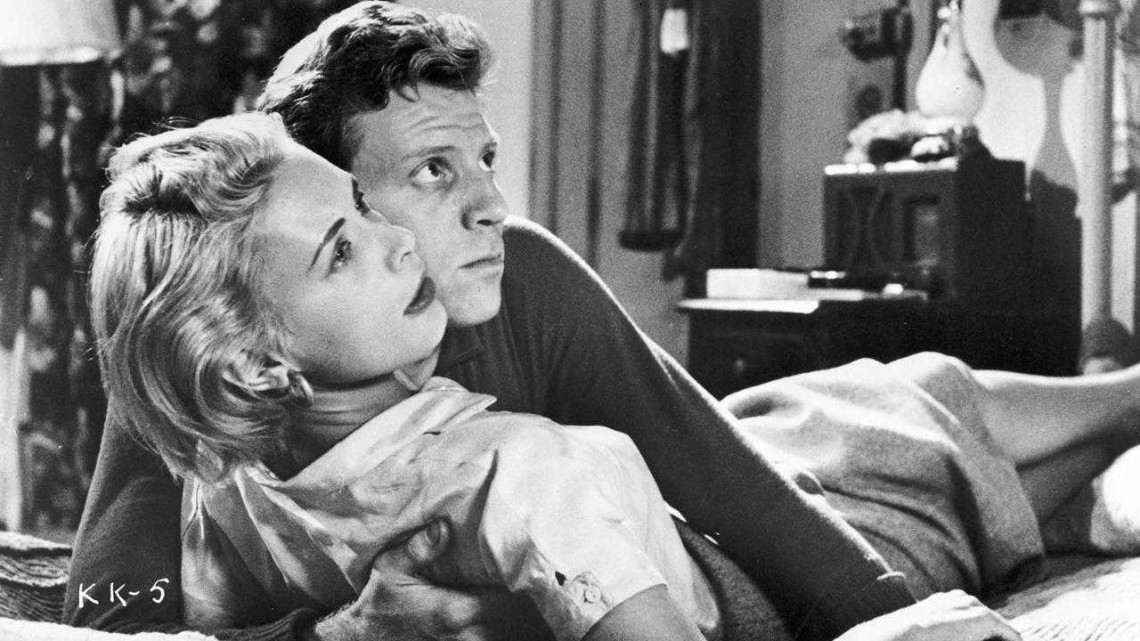The imperfect, frequently bush-league Killer’s Kiss fits almost too neatly into Stanley Kubrick’s storied career. As his second feature following Fear & Desire, which he famously sought to suppress, it figures as his last first draft before the evolutionary leap that was The Killing, a fragmented heist picture that in 1956 heralded the arrival of a director who would never again require training wheels.
The budding Kubrick aficionado can’t be blamed for letting an indefinite bout of procrastination stand between them and a first viewing of Killer’s Kiss. Everything about it, from its 67-minute running time to its reputation as a small, slight effort, to its vaguely off-putting title, screams “optional” and, indeed, when finally viewed, it doesn’t disappoint carefully managed expectations. When its aimless first 10 or so minutes give way to something resembling a plot, it becomes clear that Kubrick is less concerned with a compelling story than exhibiting characters in distress within a specific milieu.
Not to say that his most famous work would testify to the airtight, book-learned three-act structure: The Shining, more than most films, is absolutely about exhibiting characters in distress within a specific milieu. The same could be said of several of the others. As if approaching narrative as a math problem, Kubrick’s lesson learned following Killer’s Kiss was to solve for a lightweight or nonexistent plot by building a series of events on a trajectory of fate. The robbery that centers The Killing is staged practically as an afterthought, whereas all roads lead to a feisty little dog knocking over a valuable piece of luggage, releasing our hero’s last hopes for a clean getaway into machine-driven winds. Dehumanizing fate binds together the clean, swift break separating the first and second halves of Full Metal Jacket, otherwise alien to one another, or conveys Barry Lyndon‘s title character up to the highest and down to the lowest points on his Candide-like journey, or puts A Clockwork Orange‘s Alex through a series of stranger and stranger corrections, to a questionably optimistic finale.
Lacking the discipline (or, arguably, the means to make that discipline manifest) that would come later, one is tempted to write off Killer’s Kiss as a good college try from the early days of the independent producer, when the entrepreneurial spirit could arm itself with no-longer-unattainable cameras and lighting equipment, often in the hopes of making a fast buck via cheap thrills. As budgets for crime movies bottomed out, opportunities for innovation materialized from the pavement. Not suspended from the purse-strings of a complacent studio with rigid methods of production, a youngster like Kubrick had no choice but to invent the cinema more or less from scratch.
The results are understandably mixed. A hazy, lurid tale, somewhat overburdened with the disgusting, sexually aggressive Vincent (stage and screen veteran Frank Silvera), Killer’s Kiss sleeps when it tries to string together dime-novel vignettes, but comes alive when it’s distracted on its course by doodles, bric-a-brac, and eccentric detail. If any true star emerges, it’s Stanley Kubrick, Look photographer; unable to stage convincingly an event like a character walking through a doorway, he shoots a boxing match as if it’s in his blood, and handles eye-popping 1955 Times Square like an old pro. Killer’s Kiss is rife with visual experimentation and canny high-contrast lighting. Late in the picture there’s one truly memorable set piece: a knock-down, drag-out brawl in a mannequin factory. Foreshadowing the pornographic figures adorning the milk bar in A Clockwork Orange, the sweaty desperation and apocalypse symbolism also suggests the eschatological pie fight that would never make the finished version of Dr. Strangelove.


















One thought on ““Killer’s Kiss” At 60″”
Pingback: ‘Chinatown’ as Greek Tragedy, Roger Deakins’ Favorite Docs, ‘Raging Bull’ Opening, and More | MoviesandCelebrity.com